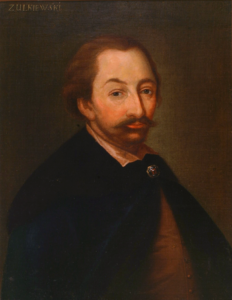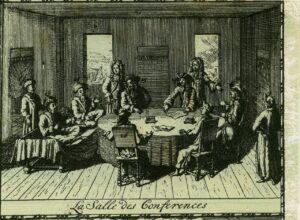The course of the boundary between Moldavia and the Polish Crown was, on the surface at least, quite clear, especially in comparison with a fuzzier Polish-Ottoman demarcation further to the east. For most of its course, it ran along the rivers of White Cheremush, Kolachin and the Dniester, extending from the hilly and forested landscape in the Bucovina towards the Black Sea steppe to the southeast.
by Michał Wasiucionek
In August 1646, a podkomorzy (chamberlain) of Podolia, Łukasz Miaskowski, received a seemingly unusual gift accompanied by a letter. Writing to the Polish nobleman, the Moldavian governor of Soroca, Ştefan, wished the addressee good health and declared his friendship; the boyar also mentioned that he sends Miaskowski a hundred of best watermelons he could find, along with forty melons. He regretted that the quality of the harvest was somewhat disappointing due to intense heat that affected the region; nonetheless, he hoped that the recipient would appreciate the fruit as a token of friendship. This was not the only time that Miaskowski would receive watermelons from Moldavia and this “fruit diplomacy” was part of the complex system of interactions between Polish-Lithuanian noblemen and their Moldavian counterparts, which underpinned and, in some instances, influenced the high politics of Eastern Europe.

In the course of the seventeenth century, the histories of Poland-Lithuania and the principality of Moldavia were intimately entangled with one another. They were also by any means a new development. As early as 1387, the Moldavian voyvode Petru Mușat swore an oath of fealty to the Polish king Władysław Jagiełło and queen Jadwiga, becoming the vassal of the Polish Crown. However, in the course of the fifteenth century, the principality gradually slipped from under Polish suzerainty, and Moldavia increasingly came into the orbit of the expanding Ottoman Empire. An attempt to reverse this trend by military means, undertaken in 1497 by King John Albert [Jan Olbracht], concluded with an embarrassing defeat; in the following years, the Crown allowed its effective suzerainty to wither away and strived to maintain peace with the Sublime Porte, but at the same time did not renounce its claims and sought to influence the political developments in Moldavia in a more informal way. However, in the course of the seventeenth century, this relatively peaceful relations began to unravel under the pressure of Cossack and Tatar raids and partly due to Polish-Lithuanian attempts to recover its position in Moldavia. A series of campaigns and periods of open warfare ensued and the periods of conflict between the Porte and the Commonwealth covered almost a third of the century. A lion’s share of these clashes took place in Moldavia, which was not only the theatre of war, but also its intended prize. However, once the dust settled with the 1699 Treaties of Karlowitz, the borders remained very much the same as at the beginning of the century. Despite numerous attempts launched by Jan Zamoyski, Stanisław Żółkiewski and king John III Sobieski, among others, in the end the Ottomans managed to hold to Moldavia and fend off Polish-Lithuanian challenge.
This bird’s-eye view of high politics, focusing on imperial encounters and full-scale military conflicts tells just one part of the layered story of Moldavian-Polish borderland. While important, it misses much of the “texture of contact” in which nobility of Ruthenia and the Ukraine and their Moldavian counterparts participated and shaped. However, these seemingly trivial interactions and ties were not only bread and butter of everyday life but could affect and even cause major political events. In doing so, friendships, alliances and enmities they created often did not conform to established state borders, but frequently criss-crossed them, adding to the complexity of political and social life in the region.

The course of the boundary between Moldavia and the Polish Crown was, on the surface at least, quite clear, especially in comparison with a fuzzier Polish-Ottoman demarcation further to the east. For most of its course, it ran along the rivers of White Cheremush, Kolachin and the Dniester, extending from the hilly and forested landscape in the Bucovina towards the Black Sea steppe to the southeast. On the right bank of the rivers lay Moldavian lands, divided between administrative districts of Cernăuți, Hotin and Soroca, each under the governors with a title pârcălab or (in Cernăuți’s case) starosta. On the other side, the adjacent territories of the Polish Crown were included into the palatinates of Ruthenia, Podolia and Bracław. This arrangement was to an extent a product of a prolonged dispute over the border region of Pokucie (Pokuttja). This piece of land, including the towns of Śniatyn (Snjatyn’) and Kolomyja had been a bone of contention since the late fourteenth century, when it was pawned by King Władysław Jagiełło to the Moldavian voyvode in exchange for a cash loan; the Crown failed to honor the agreement and the diplomatic and sometimes military conflict over the borderland continued until the first half of the sixteenth century, with the territory remaining in the Polish hands.
However, the end of the Pokucie controversy did not bring an end to border disputes, although on a local rather than diplomatic scale. In November 1611, boyars from the area of Cernăuți complained that Stefan Potocki, a member of a powerful family in the region, seized some land within the confines of the principality, intimidated the local elite and proceeded to establish settlements within a disputed area. When the Moldavian mission was dispatched to the royal court to complain about this practice, Potocki detained the envoys and cut the passages that would harm his economic interests. Eventually, the boyars were able to submit their grievances to the king, but only through the intercession of Hetman Stanisław Żółkiewski, who was a sworn enemy of the magnate. This was not the only case, when issues of Potockis’ landholdings in Moldavia became an object of concern; in 1669, Stanisław Kienarski, a Polish secretary in Moldavian employ was to seek redress for the actions of Jan Potocki, the Palatine of Bracław. In his letter to the king, Voyvode Gheorghe Duca stated: “I have received several complaints […] against Sir Jan Potocki, the palatine of Bracław that, contrary to pacts and treaties, and paying no heed to the border and boundary markers that divide my lands from those of Your Royal Majesty, occupied my lands and established villages. I’ve sent several of my men there, who reported and assert that Potocki’s lands extend into my territory. I cannot keep silent on this matter, since I have been entrusted this land by the Sublime Porte.” In short, on the one hand, what was basically a private land dispute ran the risk of implicating both the Polish-Lithuanian Commonwealth and the Ottoman Empire; on the other, the fact that the boundary was demarcated did not mean it could be easily enforced against the interests of powerful political figures.

The Potockis were by no means the only family with vested interests in Moldavian affairs. Other influential families of Ruthenia, Podolia and the Ukraine had financial and political interests in the principality. Potocki’s adversary, Stanisław Żółkiewski had his own designs for the principality, trying to put on the throne Gavril and Peter Movilă (or Mohyła), members of a Moldavian dynasty who grew up on Żółkiewski’s court. In doing so, he emulated his celebrated patron, Jan Zamoyski, who in 1595 and 1600 brought his own client, Ieremia Movilă, in Iaşi. Zamoyski’s motives were not solely driven by geopolitical considerations, since – as his contemporaries remarked – he profited handsomely from money sent by his Moldavian client and participated in full in cattle trade, the most significant source of profit in the principality. In his turn, Ieremia Movilă would subsequently try reinforce his ties with the Polish-Lithuanian elite: his four daughters were married off to members of prominent magnate families in the Ukraine and beyond; his eldest daughter, Regina-Chiajna, would become the mother of famous Prince Jeremi Wiśniowiecki and grandmother of King Michael I (r. 1669-1673). Another Moldavian voyvode, Vasile Lupu, would see his daughters marry Prince Janusz Radziwiłł and Tymish Khmelnytsky, the son of the notorious Cossack het’man.
The political instability and frequent turnover at the Moldavian throne also meant that members of the elite and some voyvodes were forced to seek refuge on the left bank of the Dniester, which facilitated social and political contacts between them and the Polish-Lithuanian nobility. In the late sixteenth and early seventeenth century, a large emigration centered around the Movilă family would be included into the ranks of the Commonwealth’s nobility and some would manage to acquire landed property. Particularly the borderland estate of Ustia near Kamieniec would frequently become the property of the exiled voyvodes, including the Movilăs and their relative, Miron Barnovschi. Similarly, in the late seventeenth century, during the reign of John III (r. 1674-1696), the number of Moldavian exile would reach around 1,000 people, many of whom would go to serve in the Polish-Lithuanian army against the Ottomans. These prolonged periods of exile not only tied the boyars closer to the political and social milieu on the northern border of the Dniester, but would also have a profound impact on Moldavian culture of the time. The most important lumanaries of Romanian letters in the seventeenth century, Grigore Ureche and Miron Costin would receive their humanist education in Jesuit colleges in Lwów and Bar; another important literary work, the translation of Psalms by Moldavian metropolitan Dosoftei, was based on Jan Kochanowski’s oeuvre. Miron Costin would even leverage his literary talents and fluency in Polish to establish a bond between himself and King John III, dedicating his History of Moldavia in Polish Rhythms to the monarch. It would be only in the beginning of the eighteenth century that the Polish influence would diminish in Moldavia, but on the borderland the contacts between the boyars and the noblemen continued unabated.

These political, cultural and familial affinities did not mean, however, that no differences existed between both sides of the Dniester. The Polish noblemen recognized similarities between themselves and Moldavian boyars, particularly as both groups drew their livelihood from landholding and serf labor; however, this did not necessarily translate into a sense of fraternity and equality between the elites. While some boyars managed to secure naturalization as members of the Polish-Lithuanian nobility, the latter’s general attitude towards their Moldavian counterparts was somewhat dismissive. In a 1553 speech, Hieronim Ossoliński stated flatly that “there are no nobles in Moldavia, since everyone there is equal and accustomed to the fact that one day you may be herding goats, only to become a grand lord overnight.” From this point of view, shared by many noblemen, the status of Moldavian elites could not compare to the hereditary prestige of their own lineages. Some naturalized boyars sought to remedy this by inventing more illustrious genealogies: for instance, the aforementioned Movilă family claimed descent from early Roman hero, Mucius Scaevola, to enhance their prestige in the eyes of their Polish peers.
There were also clear limits on what Moldavian boyars were ready to agree in their political dealings with the Commonwealth. While they were willing to build political alliances with Polish-Lithuanian nobility and the court, going as far as to recognize the Polish suzerainty over Moldavia, they nonetheless opposed any attempts at annexation of the principality to the Commonwealth or colonization attempts by the nobility; as they recognized, both measures would in the long run undermine their status as the elite of the land in favour of wealthier and more prestigious Polish-Lithuanian noblemen. In 1600, when Jan Zamoyski demanded annexation of Moldavia to the Crown, he was repudiated by his own client, Ieremia Movilă, and had to give up on his plans. Even such a pro-Polish stalwart as Miron Costin, despite his declarations of loyalty and friendship with John III, benefited from the relationship by enhancing his political position and securing his estates from depredations, but did nothing to support the monarch’s plans to conquer Moldavia. Thus, accommodation clearly had limits on the Polish-Moldavian frontier.

The treaty of Karlowitz in January 1699 ended what would turn out to be the last Polish-Ottoman conflict in history. Despite repeated attempts undertaken by the Commonwealth, Moldavia would remain within the Ottoman orbit, to a large extent due to Moldavian boyars’ opposition to the Polish-Lithuanian designs. In the eighteenth century, the weakened Commonwealth would no longer play a decisive role in defining the principality’s history. However, the underlying texture of contact remained: Moldavian boyars and their counterparts would continue to resolve local issues, exchange gifts and establish friendships. While they lost their political significance on a geopolitical scale, for the local communities, these contacts remained an integral part of everyday life.
Author: Michał Wasiucionek
Translation: Alicja Rose & Jessica Sirotin





